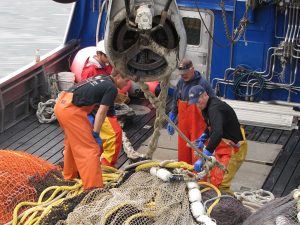Local Fish Fund Offers Loans to Next Generation
 In an effort to lower the barrier to entry in the fishing industry, to retire a “graying fleet” of vessels, and to attract a younger group of fishers into the industry, the Local Fish Fund has announced a new and innovative loan program. Loans are structured based on quotas and shares rather than fixed payments, which creates a system that is flexible and spreads risk.
In an effort to lower the barrier to entry in the fishing industry, to retire a “graying fleet” of vessels, and to attract a younger group of fishers into the industry, the Local Fish Fund has announced a new and innovative loan program. Loans are structured based on quotas and shares rather than fixed payments, which creates a system that is flexible and spreads risk.
“The cost and risk involved in accessing Alaska’s quota share fisheries are comparable to purchasing a hotel as a first step in home ownership,” said Linda Behnken, founder of the Alaska Sustainable Fisheries Trust and director of the Alaska Longline Fishermen’s Association in Sitka. “We’re looking for ways to help the next generation of fishing families get that start and build sufficient equity to eventually access conventional loans. Part of what has made it really challenging to buy into the fisheries is the uncertainty and how that will affect their ability to make fixed payments that don’t fluctuate as catches or fish prices drop,” Behnken said. “We share and reduce that risk, so the payments are based on what fishermen are paid at the dock. If the price falls, so does the payment; conversely, if they go up, it’s a bigger share.”
A recent survey reported that the average age of an Alaska fisherman is 50. Fewer young people are entering the field due to financial barriers such as a limited number of permits available as well as high vessel and equipment costs. Participants in the new Local Fish Fund loan program must be willing to participate in fishery conservation programs and agree to a variable repayment structure based on the value of their catch. As young fishers work to repay these loans, they build equity as well as credit history, making future loans and refinancing with traditional lenders an option. The “quota shares” will act as collateral for the borrower.
These loans have been structured after a great deal of feedback from local commercial fishermen, especially those associated with the halibut and sablefish industries. While traditional commercial loans require fixed payments, much like a car or home loan, Local Fish Fund has developed a strategy that uses “revenue participation” or repayment based on a percentage of the catch rather than a fixed structure. Because quotas and prices can vary wildly from one season to the next, this financing strategy spreads the risk between the borrower and the lender. The flexible approach also allows fishers to repay their loans in what is often considered a volatile industry.
This is truly a cooperative endeavor. The loan fund was set up by the Alaska Sustainable Fisheries Trust, and capitalized by The Nature Conservancy, Craft3, the Rasmuson Foundation, Catch Together, Oak Foundation, and the National Fish and Wildlife Foundation. The Fund has been initially capitalized by Catch Together and the Rasmuson Foundation in the amount of $1.5 million. The organization is currently focusing efforts on loans in Southeast Alaska. The program will strive to increase marine stewardship and leadership by collecting scientific data as well as investing in outreach and conservation education.
“Alaska has some of the most sustainably managed fisheries in the world,” says Christine Woll, the Southeast Alaska program director for The Nature Conservancy. “This is due in large part to Alaskans having an active voice in how our fisheries are managed. Encouraging local participation in our commercial fisheries helps foster a long-standing Alaska tradition of community-based stewardship of our natural resources.”
In the spirit of conservation, borrowers will be offered a 1 percent break on their loan interest when they participate in electronic monitoring and networking that keeps whales safely away from fishing gear. Behnken goes on to say, “Part of our goal is to involve more fishermen in conservation research and fisheries management. Our perspective has always been that fishermen are the best problem solvers and when we engage them, we find solutions.”
 Maritime Injury Law Blog
Maritime Injury Law Blog

